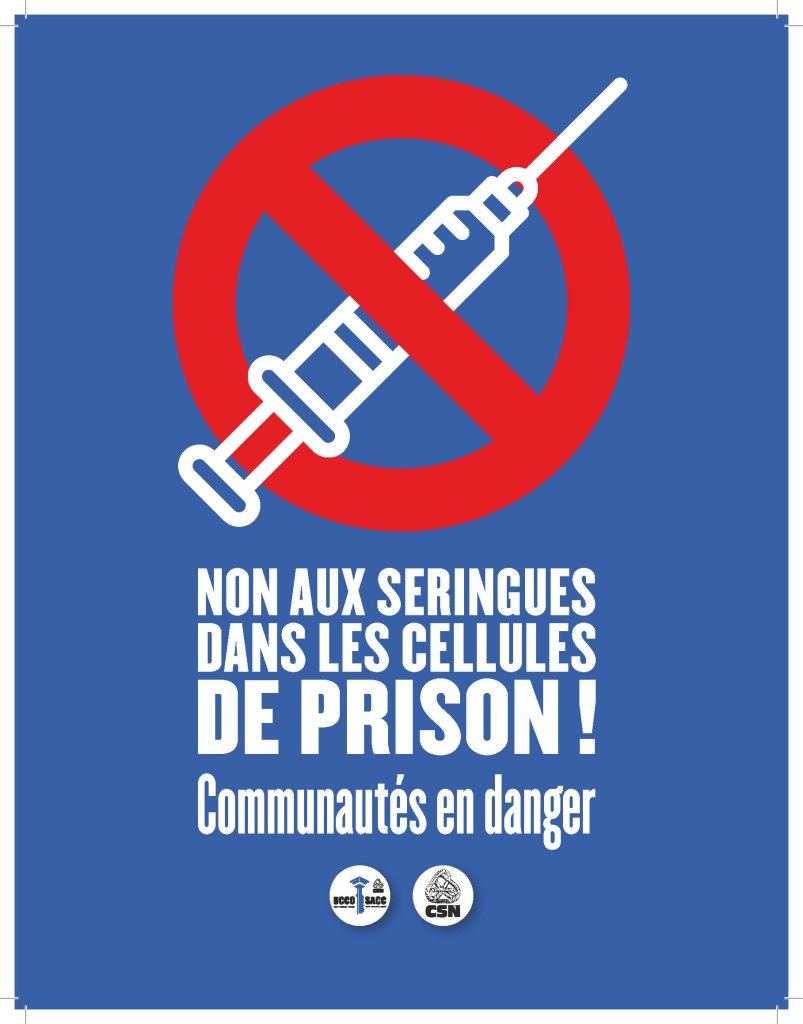RE: Reply to your letter dated December 13, 2023
Senator Pate,
Thank you for opening the dialogue on this issue and giving us the opportunity to clarify our often-misunderstood position on it.
You describe the information contained in our card as “inaccurate and misleading,” particularly with regard to the dangerous and ineffective nature of the Prison Needle Exchange Program (PNEP).
With great respect, we must correct you on this point. From the onset, it is absolutely accurate to say that the PNEP is ineffective and that a better alternative exists: the Overdose Prevention Sites (OPS). Indeed, the effectiveness of a harm reduction program is measured by its use. According to the latest available statistics, among the 10 institutions with a PNEP, there are currently 419 participants who have been accepted, but only 51 are currently active in the program, for an average of 5 inmates per institution. In comparison, there are only three OPSs, but they have a total of 86 approved patients and participants using the service, for a total of 2137 visits so far. Proportionally, the OPSs are approximately 17 times more used by inmates than the PNEP.
The results speak for themselves: before the implementation of the OPS in Drumheller, this establishment reported the largest number of overdoses per year in Canada. A review of all non-fatal overdose cases occurring in federal penitentiaries since January 1, 2017, shows that 32 non-fatal overdose cases occurred in Drumheller, resulting in a rate of 12.8 non-fatal overdose cases per year over five years. After OPS was implemented, from June 2019 to March 2020, the latest date for which data is available, only one non-fatal overdose occurred in 2019 and another in 2020.
You also mentioned being concerned about the sharing of contaminated needles among the inmate population, resulting in a high rate of HIV and HCV infection. It is important to emphasize that the PNEP in no way eliminates the possibility of sharing contaminated needles, since inmates getting needles through the PNEP have them stolen or taken by force by other inmates who do not have access to the PNEP, which puts contaminated needles back into circulation. If the objective is indeed to prevent those needles from circulating around the institutions, the OPSs are once again much more effective, since each needle is disposed of safely under the supervision of the institution’s medical staff.
Regarding harm reduction, the most recent British Columbia coroner’s report identifies using drugs while alone, escalates the possibility of an overdose, which is an issue in this harm reduction initiative that needs to be addressed.
However, the PNEP in its current form encourages, and even forces inmates to use drugs alone in their cell, without any sort of supervision. Paradoxically, by attempting to reduce harm, the PNEP creates additional harm reduction obstacles. Just last month, two inmates died alone in their cells at the Mountain Institution. Make no mistake: If the PNEP had been implemented at Mountain at that time, it would not have prevented these deaths; it would have contributed to them. In contrast, the implementation of an OPS would have allowed these two inmates to use drugs under the direct supervision of health professionals, rather than alone in their cell, which would possibly have saved their lives.
Furthermore, let us remember that 70% of people incarcerated in the Canadian Federal Correctional system had an alcohol or drug consumption problem in the one-year period preceding their incarceration (Weekes, J. R., 2002.). It is therefore essential, as part of the CSC’s rehabilitation mission, to help inmates overcome their addiction problems. However, the PNEP does not in any way address the fundamental causes of drug addiction.
While OPSs promote dialogue with medical staff, making it possible to offer resources and programs to inmates allowing them to overcome their addiction problem. The PNEP only facilitates their drug consumption without any other form of interventions to cure their addiction. OPSs offer a lasting solution to the underlying problem, while PNEP only exacerbates it.
Before the PNEP and OPS initiatives were implemented in several institutions, the Correctional Service of Canada had adopted many programs aimed at curbing the spread of infectious diseases. Programs such as providing protections against sexually transmitted diseases, bleach programs, peer support networks, Alcoholics Anonymous, Narcotics Anonymous, and vital health programs of Methadone, Suboxone and Sublocade, which aim to steer inmates away from harmful illicit drug use, have been in place for years. These programs remain in place, and in fact over recent years have seen exponential use from the inmate population. There is a difference, however, between these programs and the PNEP; these programs are rehabilitative in nature.
The PNEP does nothing to help an inmate’s rehabilitation from drug use, but in fact encourages use, which is why many inmates have petitioned against such a program.
Ultimately, in a workplace as dangerous and volatile as a prison, a needle can become a very dangerous weapon. There is no way to guarantee that it will not be used as such against an employee or inmate. Additionally, there is no way to ensure that the needle is stored safely. Thus, during a search or seizure, there is a risk that CSC employees will be injured by the needle and potentially be infected with HIV.
Even if a Threat Risk Assessment (TRA) is carried out and an inmate is deemed eligible for the PNEP program, there is no way to guarantee that the needle will not be shared with fellow inmates with malicious intent. In fact, it is very easy for an inmate who has not passed the TRA to pressure or otherwise convince a fellow inmate to obtain their syringe.
In this regard, OPSs are also safer, since they provide access to sterile syringes whilst preventing them from circulating freely within the institutions or turn them into weapons against employees, inmates, and the general public.
The superiority of the OPSs over the PNEP is therefore demonstrated empirically in Canadian correctional establishments, both in terms of security and in their capacity to truly reduce harm. They are safer and more effective than the PNEP for all stakeholders. Of course, such a program, although safer and more effective, is also more expensive.
Regardless, we are of the opinion that the health and safety of the public, inmates and our members is not something on which the government should be trying to save money. We hope that you are also of this opinion and that you will support OPSs despite their higher cost.
Best Regards,
UCCO-SACC-CSN

